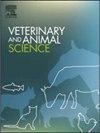Differential effects of flunixin meglumine and meloxicam on TNF- α production in LPS-stimulated equine neutrophils in vitro
IF 1.9
Q2 AGRICULTURE, DAIRY & ANIMAL SCIENCE
引用次数: 0
Abstract
Systemic inflammatory response syndrome (SIRS) induced by endotoxemia is usually secondary to colitis and is a major cause of high morbidity and mortality in horses. Non-steroidal anti-inflammatory drugs (NSAIDs), such as flunixin meglumine (FM) and meloxicam (MX), are used to improve clinical outcomes in SIRS/endotoxemia. These NSAIDs suppress tumor necrosis factor-alpha (TNF-α) levels; however, the underlying mechanisms remain unclear. The aim of this study was to investigate the inhibitory effects of FM and MX on TNF-α in lipopolysaccharide (LPS)-stimulated peripheral blood mononuclear cells (PBMCs) and neutrophils in vitro. Blood samples were collected from three healthy thoroughbred horses, and PBMCs and neutrophils were isolated using density gradient centrifugation. Cells were cultured with LPS (0.3 ng/mL) and FM or MX (5, 10, or 50 μM). TNF-α gene expression was analyzed using quantitative real-time PCR, and protein levels were measured using ELISA. No significant inhibitory effects of FM or MX on TNF-α gene or protein expression were observed in LPS-stimulated PBMCs. However, FM significantly inhibited the increase in TNF-α protein levels in LPS-stimulated neutrophils in a concentration-dependent manner (p < 0.05). MX showed a similar tendency in LPS-stimulated neutrophils, but the differences were not significant. The regulation of neutrophil-derived TNF-α by FM administration could be a promising therapeutic strategy for equine SIRS/endotoxemia, providing mechanistic insight for optimizing anti-inflammatory therapy.
氟尼新-大明与美洛昔康对体外lps刺激马中性粒细胞TNF- α生成的差异影响
由内毒素血症引起的系统性炎症反应综合征(SIRS)通常继发于结肠炎,是马高发病率和死亡率的主要原因。非甾体类抗炎药(NSAIDs),如氟尼新-甲胺(FM)和美洛昔康(MX),用于改善SIRS/内毒素血症的临床结果。这些非甾体抗炎药抑制肿瘤坏死因子α (TNF-α)水平;然而,潜在的机制仍不清楚。本研究旨在探讨FM和MX对体外脂多糖刺激的外周血单核细胞(pbmc)和中性粒细胞中TNF-α的抑制作用。采集3匹健康纯种马的血液样本,采用密度梯度离心分离pbmc和中性粒细胞。用LPS (0.3 ng/mL)和FM或MX(5、10或50 μM)培养细胞。采用实时荧光定量PCR法分析TNF-α基因表达,ELISA法检测蛋白水平。在lps刺激的PBMCs中,FM和MX对TNF-α基因或蛋白表达均无明显抑制作用。然而,FM显著抑制lps刺激的中性粒细胞中TNF-α蛋白水平的升高,且呈浓度依赖性(p < 0.05)。MX在lps刺激的中性粒细胞中表现出类似的趋势,但差异不显著。通过FM给药调节中性粒细胞来源的TNF-α可能是一种有希望的治疗马SIRS/内毒素血症的策略,为优化抗炎治疗提供机制见解。
本文章由计算机程序翻译,如有差异,请以英文原文为准。
求助全文
约1分钟内获得全文
求助全文
来源期刊

Veterinary and Animal Science
Veterinary-Veterinary (all)
CiteScore
3.50
自引率
0.00%
发文量
43
审稿时长
47 days
 求助内容:
求助内容: 应助结果提醒方式:
应助结果提醒方式:


